The End of the Day

© Don McAllester
Photo 235
Returning to the bay at Fascadale in the “Wee” coble after fishing the nets. Through the season the coble was kept on a mooring in the bay unless there was a northerly or north westerly gale forecast in which case the boat was moved to “Jonnie’s” a very sheltered spot along the rocky shore east of Fascadale The coble engine was being controlled by Rhoddy Macleod, the then owner of Fascadale. He is wearing the traditional knee length frock oilskin. The coble is approaching the dinghy ,which the crew use the dinghy to get themselves and the catch ashore.
The fishing season started in late spring but the still rough weather and the number of fish to be caught meant that activity ashore at Fascadale only really started in May with the nets going into the sea in early June. There was lots of preparatory work to be done: nets checked and repaired, boats serviced and painted, moorings to be laid and much more. The season officially closed on 26th August but by that time there were very few fish being caught so in most years all the gear would be out of the water by mid August. Once the gear was ashore there was still plenty to do, scrubbing weed growth off all the ropes and chains, cleaning, drying and properly storing it all and the tarring.
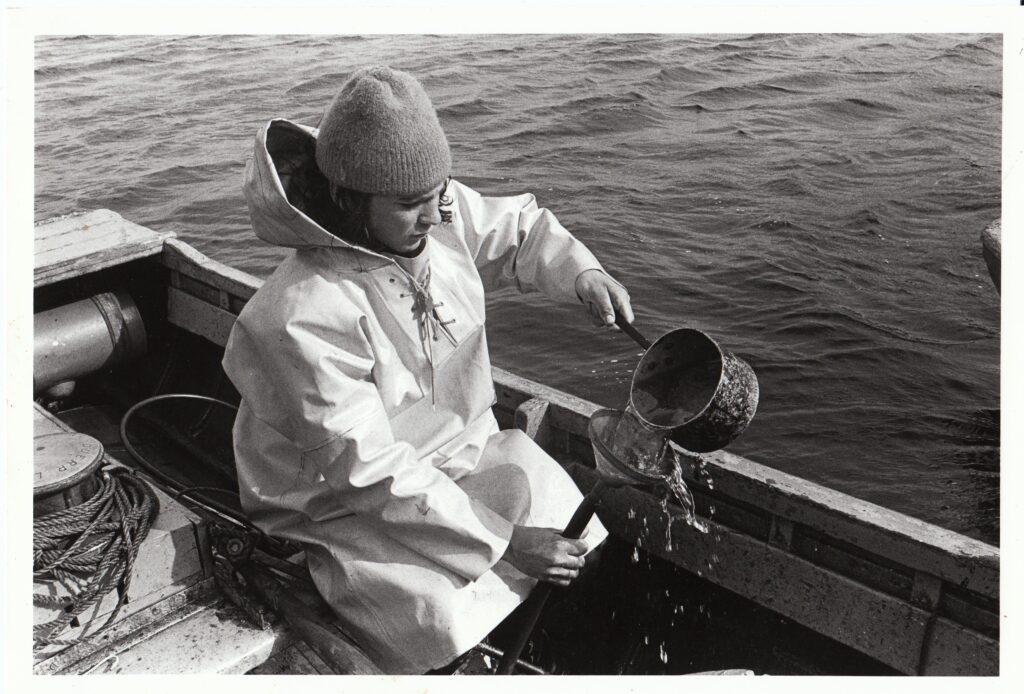
© Don McAllester
Photo 236
The mechanical bilge pump only ran when the engine was on. It was not the easiest pump to get started: it required water being poured into it to get the suction going and the device to work. To do this one had to find the funnel and the pan then start pouring water. This was maybe not the best set up to deal with an emergency. There was no manual bilge pump but the boat did have a couple of buckets
The fisherman is wearing a frock oilskin see photo III link
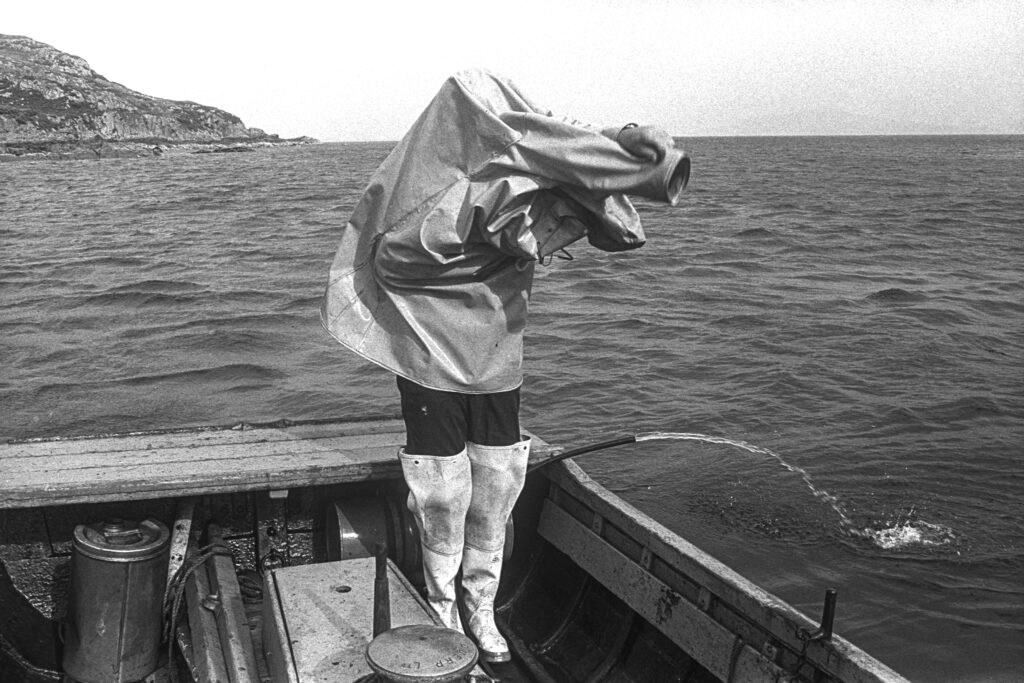
© Don McAllester
Photo 237
Rhoddy taking off his frock oilskin. These garments came down to the knee ( see photo JJJ link) and were made of a heavy synthetic cloth. They were completely waterproof. They had a hood but the cuffs were loose. The combination of frock oilskin and thigh boots worked well. There was nothing for a net to hook onto: you could stand in the water by the beach to load and unload the boat and at sea they kept the water out. However these were the days before “breathable” fabrics: working the nets was strenuous work so with no way for the perspiration to escape by the end of the day you could end up fairly damp.
The frock oilskin and thigh boot combination would have made it very difficult had you gone overboard.
The water flowing out of the hose to the right of the picture is coming from the boat’s mechanical bilge pump. Photo 333(link) shows this pump being primed. The engine had to be running for the pump to work. There was no manual bilge pump, just a couple of buckets.
This old wooden boat was quite “tight”, she did not leak much but she did have a low “freeboard” (height of the sides above the water) so she would take on spray. At the end of the day the boat was always washed down with buckets of sea water.
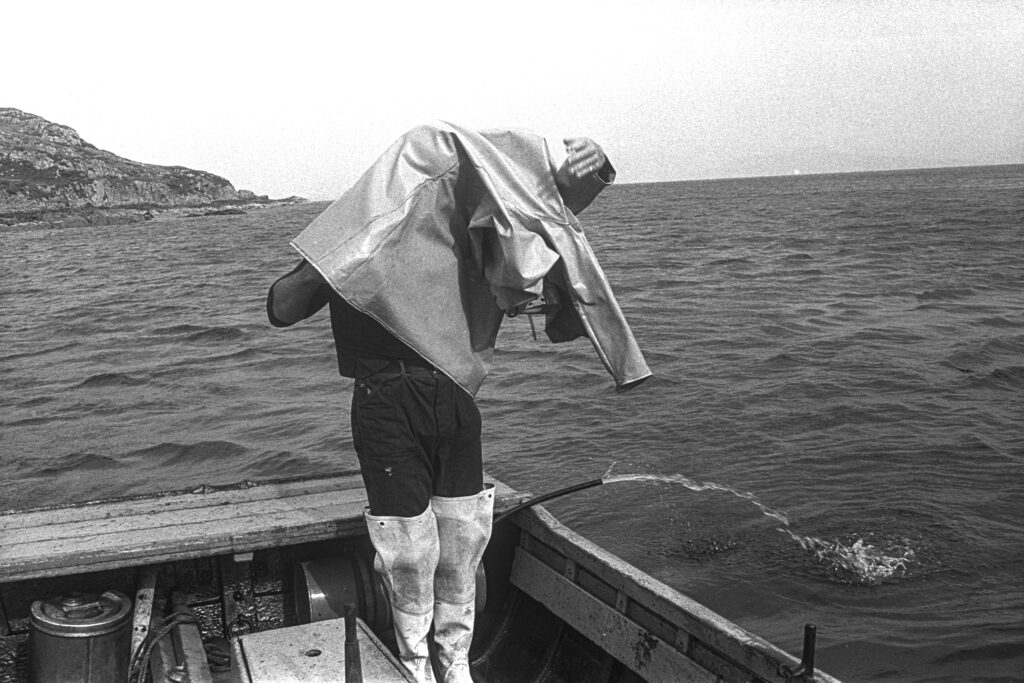
© Don McAllester
Photo 238
Almost there
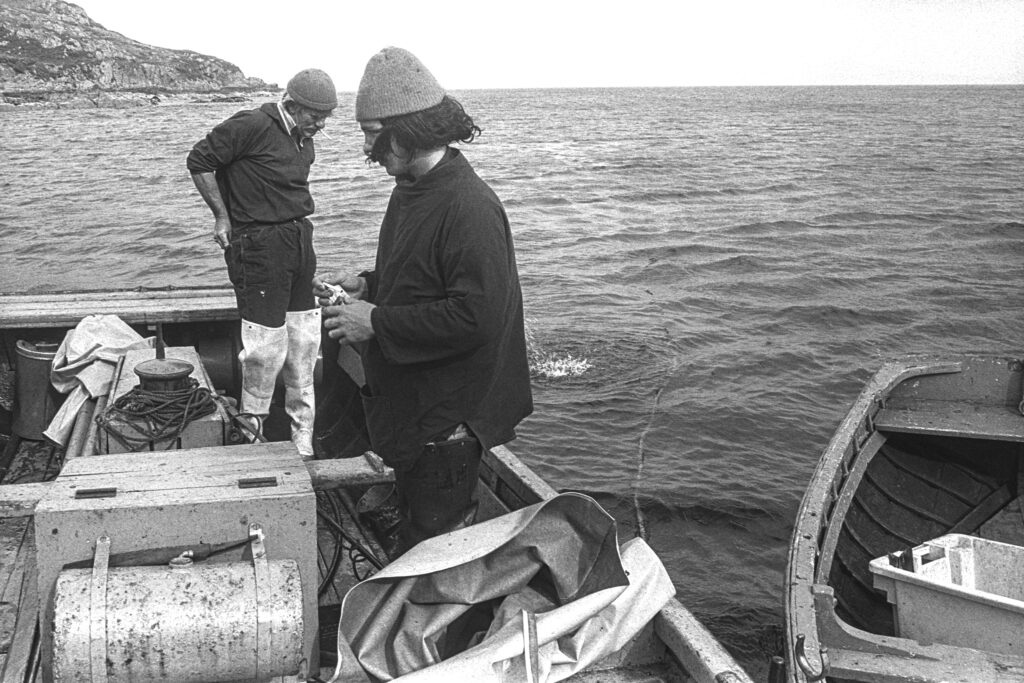
© Don McAllester
Photo 239
The oilskins are now off, the fish box is in the dinghy, the bilge pump is still working so the engine must still be running……time for a cigarette
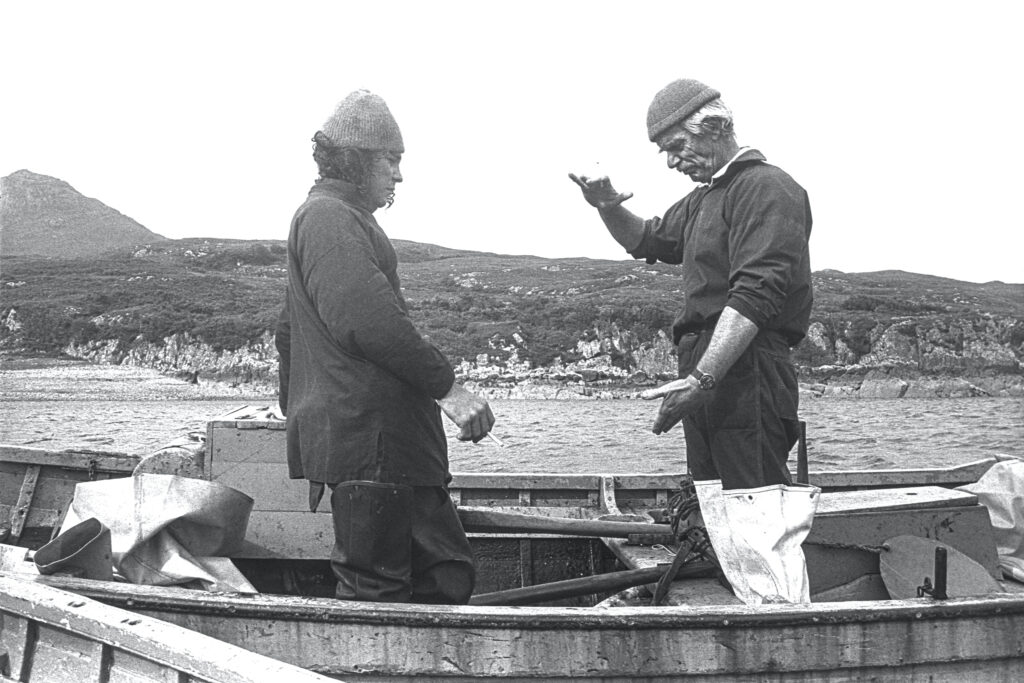
© Don McAllester
Photo 240
And you should have seen the one that got away……..

© Don McAllester
Photo 241
Rhoddy and Paul pulling the “grey” dinghy up the beach after returning from a fishing trip. The “wee” coble is in the background on her mooring. To get the boat right up the beach a long wire was attached to the front of the boat then a LandRover used to pull it up. Fascadale owned two very sturdy and very old clinker dinghies, the “grey” one and the “blue” one. These boats had to be painted on the outside then tarred on the inside each year. The tar helped keep them watertight. All very very traditional
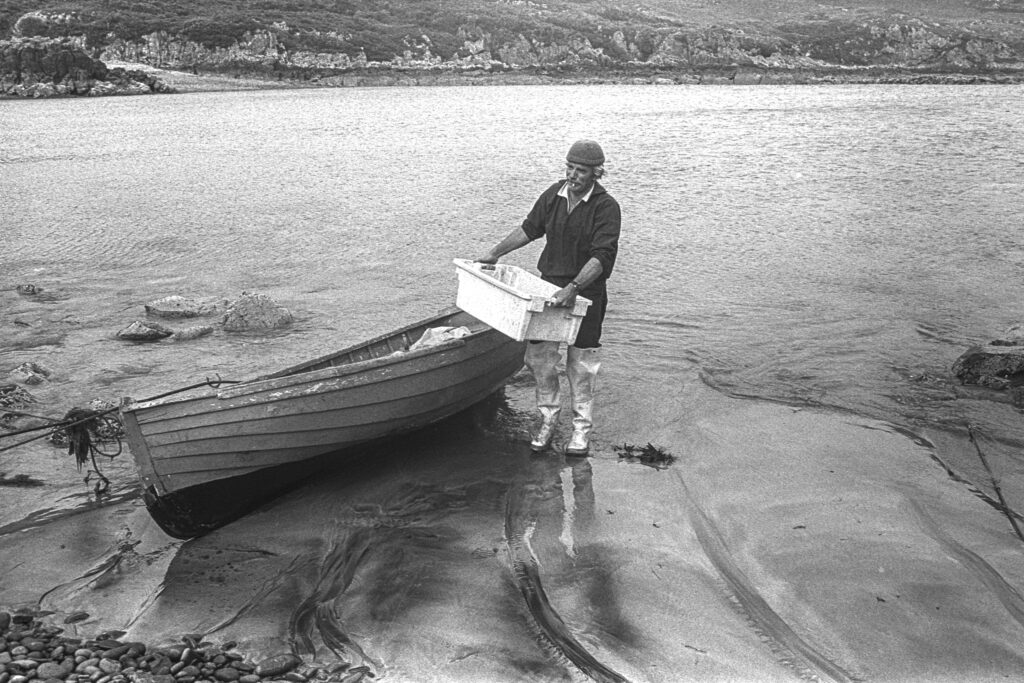
© Don McAllester
Photo 242
Rhoddy carries the morning catch up the beach. The plastic fish boxes used at Fascadale were all gifts from the sea: flotsam or jetsam washed up on the beach.
The dinghy has been left with a swell line hooked through its starboard rowlock and its long painter (bow rope) tied to the same swell line well up the beach. This meant the boat was kept in place through the rise and fall of the tide and could be pull in as the tide refloated it and in time for the afternoon fishing. The other swell line is just visible to the right of the photo
The boat in the photo is one of the two old clinker built dinghies, the “Grey dinghy” . Unfortunately being dragged down and towed up the stony beach was damaging to the boats. If you look carefully at this photo you can see the stem and keel timbers have come apart. Wood working skills at
Fascadale were very basic so no really good repair was carried out
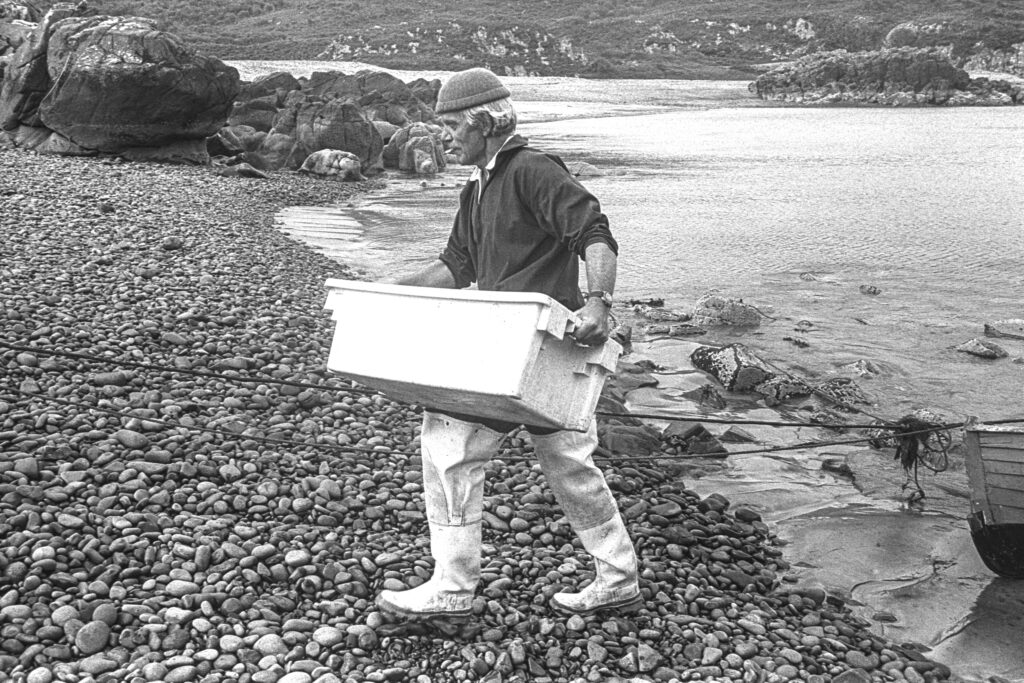
© Don McAllester
Photo 243
The beach at Fascadale changed shape every year with the winter storms. The “raised beach” the stony part would some years be an even gradient, other years it would be a series of steep ridges.
In this photo the dinghy is resting on the sand that would become visible at the bottom of the tide. The dinghy is held in place by her long painter (bow rope) and the swell line. (Link 333)
Also visible are the rocks that uncovered at low water. These were always as hazard if the coble had to be brought alongside the beach to unload (link 444)

© Don McAllester
Photo 244
The catch has been brought ashore in the white plastic fish boxes. Bobby Macleod, the wife of the proprietor managed the washing, weighing, packing and dispatch of the fish. From the plastic boxes the fish went into the zinc bath for a quick rinse then onto the wooden box scale visible hanging in the doorway. From there it was into a wooden fish box lined with wet newspaper for insulation, then covered with crushed ice and then the lid nailed down. The fish were not gutted but sent away whole and always packed in the boxes belly up
The shed behind the tin bath, the engine shed, housed the ice making machine. This petrol driven contraption using compressed refrigeration gas and a brine tank formed ice in the heavy metal cases visible behind Bobby Macleod . The big blocks of ice were put through a turnip grinder, a mangle, to be crushed. This laborious process was replaced a few years later when mains electricity finally reached Fascadale
The crew are going into the packing shed to change out of their sea going gear before helping with handling of the catch.
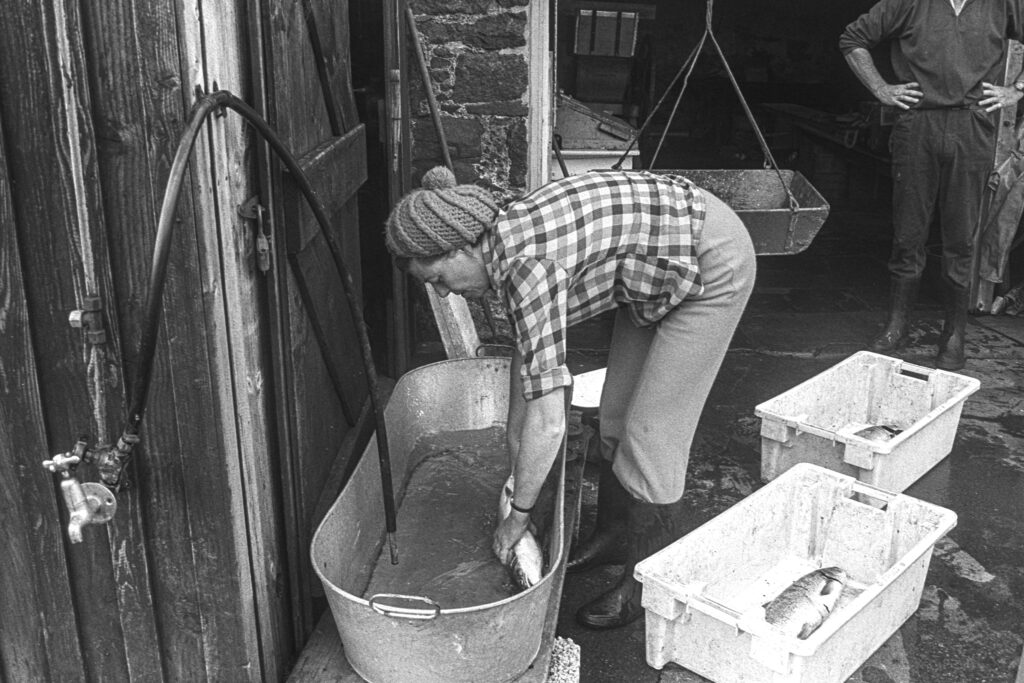
© Don McAllester
Photo 245
After the catch was brought ashore the fish were rinsed, weighed and packed
In this photo Mrs Macleod is rinsing the fish in the zinc bath beside the engine shed and outside the packing shed.
The wooden tray hanging in the background was used for weighing the catch. It was suspended from an old fashioned round brass scale.
When the weighing and packing of the fish was complete the tin bath was tipped out then it and the fish boxes were hosed clean
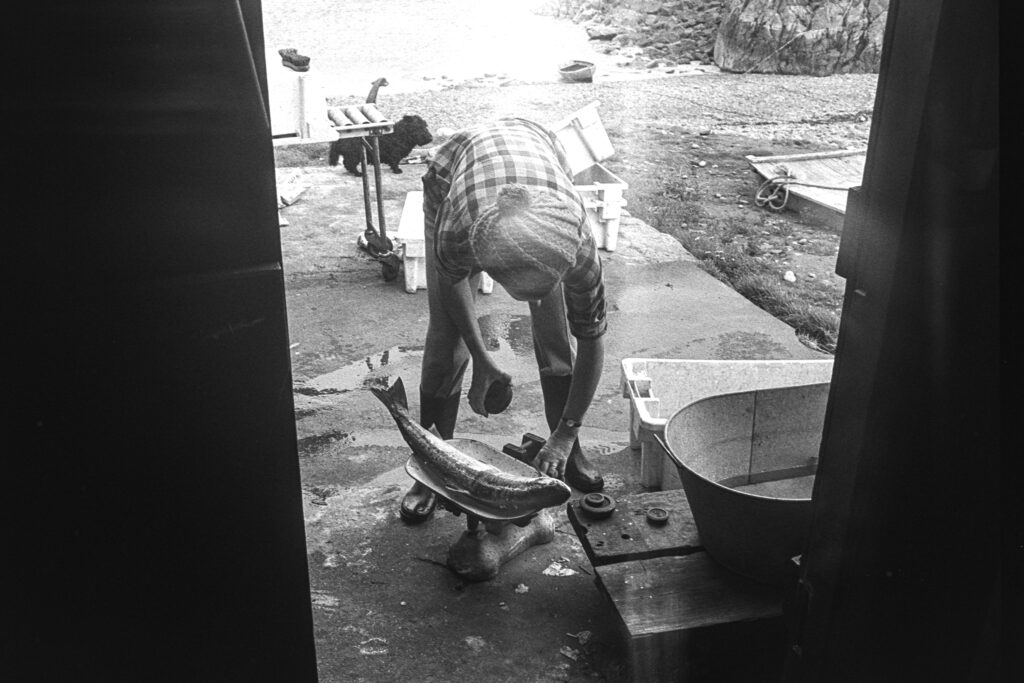
© Don McAllester
Photo 246
Salmon landed at Fascadale were sent to the Glasgow fish market to be sold. That market divided the fish into “Salmon” or “Grisle” A salmon was a fish of over 8lbs, a grilse a fish of under 8lbs. The market paid more per pound for salmon than it did for grilse
It was usually very easy to identify a salmon from a grilse visually. Fish that one was uncertain of were weighed individually. Mrs Macleod, Bobby, is weighing such a fish in the photo.
When the boxes were packed ready to go to market they were labelled with the number of salmon and grilse in each box with the number and total weight of each category
This picture was taken from just inside the engine shed and shows the tin bath for rinsing the fish, the dinghy on the swell line at the bottom of the beach, (Links) the black Scotty dog, “Gus” and to the right the front end of the wooden sledge used for dragging nets up the beach and then onto the net green.
The sledge would be manually pulled down the beach, loaded from the boat, then attached at the end of a long wire rope to be towed up the beach by LandRover. At the top of the beach the wire would be unhooked, then the vehicle turned, the sledge reattached directly to the vehicle then towed to the green for unloading. The crew had to walk beside the sledge to make sure none of the net slid off and under the sledge runners which would have badly damaged the net. Salmon fishing at Fascadale was labour intensive.

© Don McAllester
Photo 247
Paul outside the bothy at the end of the day
